Basque Country (autonomous community)
| Basque Country Euskadi a (Basque) País Vasco or Euskadi (Spanish) | |||
|---|---|---|---|
| Autonomous community of Spain | |||
| Autonomous Community of the Basque Country Euskal Autonomia Erkidegoa b (Basque) Comunidad Autónoma del País Vasco (Spanish) | |||
| |||
|
Anthem: | |||
.png) Location of the Basque Country community in Spain. | |||
| Coordinates: 42°50′N 2°41′W / 42.833°N 2.683°WCoordinates: 42°50′N 2°41′W / 42.833°N 2.683°W | |||
| Country | Spain | ||
| Largest city | Bilbao (Bilbo) | ||
| Capital | Vitoria-Gasteiz (de facto) | ||
| Provinces |
Álava, Biscay, Gipuzkoa | ||
| Government | |||
| • Type | Devolved government under constitutional monarchy | ||
| • Body | Basque Government | ||
| • Lehendakari (Head of the government) | Iñigo Urkullu (EAJ/PNV) | ||
| Area | |||
| • Total | 7,234 km2 (2,793 sq mi) | ||
| Area rank | 14th (1.4% of Spain) | ||
| Population (2014) | |||
| • Total | 2,166,184 | ||
| • Density | 300/km2 (780/sq mi) | ||
| • Rank | 7th (4.9% of Spain) | ||
| Demonym(s) |
Basque euskaldun vasco (m), vasca (f) | ||
| Area code | +34 94- | ||
| ISO 3166 code | ES-PV | ||
| Statute of Autonomy | 25 October 1979 | ||
| Official languages |
Basque Spanish | ||
| Parliament | 75 deputies | ||
| Congress | 19 deputies (of 350) | ||
| Senate | 15 senators (of 266) | ||
| Website | Basque Government | ||
|
a. ^ Also Euskal Herria, according to the Basque Statute of Autonomy . b. ^ Also Euskal Herriko Autonomia Erkidegoa, according to the Basque Statute of Autonomy. | |||
The Basque Country (/ˈbæsk/, /ˈbɑːsk/; Basque: Euskadi [eus̺kadi]; Spanish: País Vasco [paˈis ˈβasko]; French: Pays basque) is an autonomous community of northern Spain. It includes the Basque provinces of Álava, Biscay and Gipuzkoa.
The Basque Country or Basque Autonomous Community was granted the status of nationality within Spain, attributed by the Spanish Constitution of 1978. The autonomous community is based on the Statute of Autonomy of the Basque Country, a foundational legal document providing the framework for the development of the Basque people on Spanish soil, although the territory of Navarre was left out and made into a separate autonomous community.
Currently there is no official capital in the autonomous community, but the city that holds the Basque Parliament, the headquarters of the Basque Government and the Basque Autonomous Community's President's residency (Ajuria Enea Palace) is Vitoria-Gasteiz, located in the province of Álava. Whilst Vitoria-Gasteiz is the largest municipality in area, with 277 km2 (107 sq mi), Bilbao (or Bilbo in Basque) is the largest in population, with 353,187 people, located in the province of Biscay within a conurbation of 875,552 people.
The term Basque Country may also refer to the larger cultural region (Basque: Euskal Herria), the home of the Basque people, which includes the autonomous community.
Geography
The following provinces make up the autonomous community:
- Álava (Basque Araba), capital Vitoria-Gasteiz
- Biscay (Spanish Vizcaya, Basque Bizkaia), capital Bilbao-Bilbo
- Gipuzkoa (Spanish Guipúzcoa), capital Donostia-San Sebastián
Features
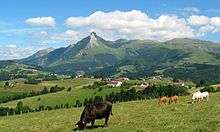
The Basque Country borders Cantabria and the Burgos province to the west, the Bay of Biscay to the north, France (Nouvelle-Aquitaine) and Navarre to the east and La Rioja (the Ebro River) to the south. The territory has three distinct areas, which are defined by the two parallel ranges of the Basque Mountains. The main range of mountains forms the watershed between the Atlantic and Mediterranean basins. The highest point of the range is in the Aizkorri massif (1551 m). The three areas are:
Atlantic Basin
Formed by many valleys with short rivers that flow from the mountains to the Bay of Biscay, like the Nervión, Urola or Oria. The coast is rough, with high cliffs and small inlets. The main features of the coast are the Bilbao Abra Bay and the Estuary of Bilbao, the Urdaibai estuary and the Bidasoa-Txingudi Bay that forms the border with France.
Middle section
Between the two mountain ranges, the area is occupied mainly by a high plateau called Llanada Alavesa (the Álava Plains), where the capital Gasteiz is located. The rivers flow south from the mountains to the Ebro River. The main rivers are the Zadorra River and Bayas River.
Ebro Valley
From the southern mountains to the Ebro is the so-called Rioja Alavesa, which shares the Mediterranean characteristics of other Ebro Valley zones. Some of Spain's production of Rioja wine takes place here.
Climate
The Basque mountains form the watershed and also mark the distinct climatic areas of the Basque Country: The northern valleys, in Biscay and Gipuzkoa and also the valley of Ayala in Álava, are part of Green Spain, where the oceanic climate is predominant, with its wet weather all year round and moderate temperatures. Precipitation average is about 1200 mm.
The middle section is more influence by the continental climate, but with a varying degree of the northern oceanic climate. This gives warm, dry summers and cold, snowy winters.
The Ebro valley has a pure continental climate: winters are cold and dry and summers very warm and dry, with precipitation peaking in spring and autumn. Precipitation is scarce and irregular, as low as 300 mm.
Demography

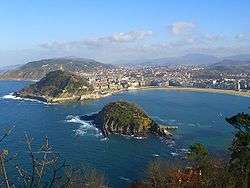
Almost half of the 2,155,546 inhabitants of the Basque Autonomous Community live in Greater Bilbao, Bilbao's metropolitan area. Of the ten most populous cities, six form part of Bilbao's conurbation (Bilbao, Barakaldo, Getxo, Portugalete, Santurtzi and Basauri), which is also known as Greater Bilbao.
With 28.2% of the Basque population born outside this region,[1] immigration is crucial to Basque demographics. Over the 20th century most of this immigration came from other parts of Spain, typically from Galicia or Castile and León. Over recent years, sizeable numbers of this population have returned to their birthplaces and most immigration to the Basque country now comes from abroad, chiefly from South America.[1]
Major cities
- Bilbao-Bilbo (348,574)
- Vitoria-Gasteiz (242,082)
- San Sebastián-Donostia (186,409)
- Barakaldo (100,502)
- Getxo (83,000)
- Irun (61,195)
- Portugalete (47,756)
- Santurtzi (46,978)
- Basauri (42,971)
- Errenteria (38,767)
Languages

Spanish and Basque are co-official in all territories of the autonomous community. The Basque-speaking areas in the modern-day autonomous community are set against the wider context of the Basque language, spoken to the east in Navarre and the French Basque Country. The whole Basque speaking territory has experienced both decline and expansion in its history. The Basque language experienced a gradual territorial contraction throughout the last nine centuries,[2] and very severe deterioration of its sociolinguistic status for much of the 20th century due to heavy immigration from other parts of Spain, the virtual nonexistence of Basque language schooling, and national policies implemented by the different Spanish régimes (see Language policies of Francoist Spain). After the advent of the Statute of Autonomy of the Basque Country in 1982 following Franco's death, this reductive trend was gradually reversed thanks to the Basque language schools and the new education system. Basque has always had a strong presence in most of Gipuzkoa, central and eastern Biscay and the northern edge of Álava, while most Basque speakers in western Biscay and the rest of Álava are second-language speakers.
The 2006 sociolinguistic survey[3] of all Basque provinces showed that in 2006 of all people aged 16 and above in the Basque Autonomous Community, 30.1% were fluent Basque speakers, 18.3% passive speakers and 51.5% did not speak Basque. The percentage was highest in Gipuzkoa (49.1% speakers) and lowest in Álava (14.2%). These results represent an increase on previous years (29.5% in 2001, 27.7% in 1996 and 24.1% in 1991). The highest percentage of speakers can now be found in the 16-24 age range (57.5%) vs 25.0% in the 65+ age range.
History
- This section is about the history of the Autonomous Community since 1978. See also History of the Basque people
The forerunner of the Gernika Statute was the short-lived Statute of Autonomy for Álava, Gipuzkoa and Biscay, which came to be enforced in October 1936 just in Biscay, with the Spanish Civil War already raging, and which was automatically abolished when the Spanish Nationalist troops occupied the territory.
Before the Spanish Constitution of 1978 and its system of autonomous communities, these three provinces were known in Spanish as the Provincias Vascongadas since 1833.[4] The political structure of the new autonomous community is defined in the Gernika Statute, which was approved by a majority in a referendum held on 25 October 1979. Nowadays it is one of the most decentralized regions in the world; in this regard it has been described as having "more autonomy than just about any other in Europe"[5] by The Economist.

As regards the bounds to the Spanish Constitution, Basque nationalists cite the fact that in the 1978 Spanish Constitution referendum, which was passed with a majority of votes and a poor turnout in this area, the Basque Country had the highest abstention[6] (the Basque Nationalist Party had endorsed abstention on the grounds that the Constitution was being forced upon them without any Basque input). To this, the "NO" vote in this referendum was also higher in the Basque Country than in the rest of the state. All in all, many Basques believe that they are not bound to a constitution that they never endorsed.
The Statute of Autonomy of the Basque Country is an organic law but powers have been devolved gradually during decades according to re-negotiations between the Spanish and the consecutive Basque regional governments to reach an effective implementation, while the transfer of many powers are still due and has always been a matter of heated political discussion. Basque nationalists often put down this limitation in the devolution of powers to concessions made to appease the military involved in the 23-F coup d'état attempt (1981).
In 2003, the governing Basque Nationalist Party (PNV) proposed to alter this statute through the Ibarretxe Plan. The Ibarretxe bill was approved by absolute majority in the Basque Parliament after much discussion, as it was subject to lengthy legal objections—on the grounds that it contradicts the Spanish Constitution—that were ultimately overcome. Despite its mandate of the majority of the autonomous Parliament, the main two parties in Spain (PSOE, PP) imposed a blockade on a discussion of the Plan in the Spanish Parliament (Madrid Cortes Generales), resulting in its rejection for debate by a large majority of that Parliament in January 2005.
Since the first autonomic cabinet, the Basque Nationalist Party has held office in the Basque Autonomous Community except for a 2009-2012 term, led by Patxi Lopez (PSE-PSOE). The current Basque prime minister is Iñigo Urkullu, also a member of the Basque Nationalist Party.
Politics
Government
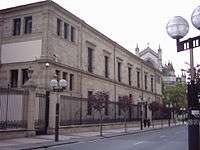
The current laws configure the autonomous community as a federation of its present-day three constituent provinces. These western Basque districts kept governing themselves by their own laws and institutions even after the Castilian conquest in 1200. The new king upheld their institutional system issued from the consuetudinary law prevalent in Basque and Pyrenean territories. This limited self-government, similar to the one for Navarre, was partially suppressed in 1839 and totally in 1876 in exchange for an agreement on tax-collection and a number of administrative prerogatives. These in turn were suspended under Franco for Gipuzkoa and Biscay, but restored by the Spanish Constitution of 1978.
The post-Franco Spanish Constitution of 1978 acknowledges "historical rights" and attempts compromise in the old conflict between centralism and the different national identities (Basque, Catalan, and Galician). A specific approach to the national realities in Spain was eventually diffused by granting autonomous administrations and parliaments to all regions of Spain (e.g. Castile and León, Catalonia, the Valencian Community, etc.), while the Basques, Catalans, and Galicians were acknowledged with historic specificity. Provincial governments (diputación foral) with actual relevant attributes (taxation, etc.) were restored only in the autonomous communities of the Basque Country and Navarre, after the latter detached from the Basque political process. The provinces in the Basque Country still perform tax collection in their respective territories, but with limited margin in decision making under the Spanish and European governments. Under this intricate system, the Diputaciones Forales (Basque: Foru Aldundiak) administer most of each of the provinces but are coordinated by the autonomous Basque Government (Spanish Gobierno Vasco, Basque: Eusko Jaurlaritza).

The autonomous community has its own police force (the Ertzaintza), controls Education and Health Systems, and has a Basque radio/TV station. These and only some of the powers acknowledge in the Gernika Statute have since 1980 been transferred to the Autonomous Community by the Cortes Generales under the Gernika Statute.[7][8]
The seats of the Basque Parliament and Government are in Vitoria-Gasteiz, so this is the capital city de facto, but the Basque Autonomous Community has no capital de iure.[9][10] The Parliament is composed of 25 representatives from each of the three provinces. The Basque Parliament elects the Lehendakari (President of the Autonomous Community of the Basque Country) who forms a government following regular parliamentary procedures. Until 2009 all Lehendakaris (even those in 1937 and during the exile) have been members of the Basque Nationalist Party (Euzko Alderdi Jeltzalea) (moderate and Christian-Democrat) since 1978. Despite their continued leadership role, they have not always enjoyed majorities for their party and have needed to form coalitions with either Spain wide parties or left-leaning Basque nationalist parties, often governing in a difficult minority position. Since 1982 until the late 1990s, Basque nationalists ideologically closer to ETA refused to turn out in the Basque parliament, a significant wedge of the parliament.

Currently, the Basque Government is headed by Iñigo Urkullu (PNV). In the 2012 Basque parliamentary election, the PNV obtained a plurality of the votes, followed by the left-wing nationalist coalition EH Bildu (Eusko Alkartasuna, Sortu, Alternatiba).
Present-day political dynamics
ETA's permanent ceasefire (2010-2011) opened the possibility of new governmental alliances and has enabled EH Bildu's electoral success and rise to governmental institutions (Gipuzkoa, capital city Donostia).
Territorial issues
The statute, insofar as it is addressed and provides an administrative framework for the Basque people, provides the mechanisms for neighbouring Navarre to join the three western provinces if it wishes to do so, since at least part of it is ethnically Basque. The Basque Government used the "Laurak Bat", which included the arms of Navarre, as its symbol for many years. The Navarrese Government protested, and tribunals ruled in their favour. The Basque Government replaced it with an empty red field.
Navarre is one of the historical Basque territories and even claimed by the Basque nationalists as the core of the Basque nation. There are also two enclaves surrounded by Basque territory—Treviño (Basque: Trebiñu) and Valle de Villaverde (Basque: Villaverde-Turtzioz)—which belong to the fellow neighbouring communities of Castile and León and Cantabria respectively, for which a legal connection to the Basque Country has become an on-off matter of political discussion.
Economy
The Basque Autonomous Community ranks first in Spain in terms of per capita income, with gross domestic product (GDP) per capita being 40% higher than that of the European Union and 33.8% higher than Spain's average in 2010, at €31,314.[11][12] Industrial activities were traditionally centered on steel and shipbuilding, mainly due to the rich iron ore resources found during the 19th century around Bilbao. The Estuary of Bilbao was the center of the Basque Country's industrial revolution during the 19th and the first half of the 20th century. These activities decayed during the economic crisis of the 1970s and 1980s, giving ground for the development of the services sector and new technologies.
Today, the strongest industrial sectors of the Basque Country's economy are machine tool, present in the valleys of Biscay and Gipuzkoa; aeronautics in Vitoria-Gasteiz; and energy, in Bilbao.
The main companies in the Basque Country are: BBVA bank, Iberdrola energy company (both of them have their headquarters in Bilbao), Mondragón Cooperative Corporation—MCC, the largest cooperative in the world—Gamesa wind turbine producer and CAF rolling stock producer. MCC's business leadership in the Basque Country hangs in the balance after Fagor, its flagship cooperative of household appliances and goods manufacturing, declared bankruptcy in 2014.
8 in 10 Spanish municipalities with the lowest unemployment rates lay across this autonomous community in 2015, standing out such towns as Arrasate, Portugalete and Barakaldo with a strong manufacturing industrial make-up.[13] The Basque Autonomous Community ranked above other communities in Spain in terms of resilience in the face of the economic crisis, going on to become a beacon and matter of study in Europe.[14]
In 2013 the Basque Country outperformed Spain in several parameters, but economic overall figures were highly variable. Spanish figures are subject to conspicuous seasonal fluctuation, relying on its tourist and services sectors, while Basque performance is rather based on mid- and long-term results according to its more industrial approach. Unemployment in this autonomous community rises to 15.76% (12.75% in Gipuzkoa), the lowest in Spain[15] at a percentage higher than the EU average (10.8%), but still way ahead of the Spanish overall of around 26%, the second highest rate in the EU.
In regards to GDP performance, 2013 was a negative year for the Basque Autonomous Community. It underwent a decline rate in GDP of -1.9%, somewhat higher than the Spanish percentage, -1.2%. In the last term of 2013, the public debt of the Basque Autonomous Community stood at 13.00% of its GDP, totalling 3,753 € per capita,[16] as compared to Spain's overall 93.90%, totalling 20,383 € per capita.[17]
Basque Government's high-ranking officials, as well as Basque-based party leaders and personalities, have protested and voiced their concern for the detrimental effects austerity measures passed by the Spanish Government as of 2011, overruling Basque taxation powers, may be having on industry and trade, especially export. The former have strongly advocated for a participation along with Navarre in the Ecofin with a full membership, in order to defend Basque interests in line with its own reality and fiscal status, and not as a Spanish subsidiary.
Transport

The strategic geographical location of the Basque Country as a link between the northwest and centre of Spain and the rest of Europe makes this territory heavily transited.
Road
The main backbones of road transport are the AP-8 motorway which links Bilbao, San Sebastián and the French border and the A-1 motorway which links San Sebastián and Gasteiz with central Spain. Other important routes include the AP-68 motorway which links Bilbao with the Mediterranean.
Rail
Eusko Trenbide Sarea (Basque Railway Network) is the Basque Government-owned company that maintains and creates the railway infrastructure in the autonomous region. EuskoTren (Basque Train) is the Basque Government-owned narrow gauge rail company that operates commuter services in Bilbao and San Sebastián, intercity Bilbao-San Sebastián service, and EuskoTran tram services in Bilbao and Vitoria-Gasteiz.
Metro Bilbao operates the two metro lines that serve the Greater Bilbao area.
The Spanish government owns two main RENFE broad gauge lines that link Gasteiz with San Sebastián and Bilbao with central Spain. It also operates Cercanías commuter lines in both Bilbao and San Sebastián.
FEVE narrow gauge company operates a commuter line between Bilbao and Balmaseda and links Bilbao with the rest of northern Spain.
A new high-speed network (called Basque Y) currently under construction will link the three capitals in 'Y' formation. It is scheduled to be completed in 2017, including a connection with the French TGV network in Hendaye.[18] Because of the rough geography of the territory, most of the network will run through tunnels, with a total estimated cost of up to €10billion.
The estimated ecological impact of the project has encouraged the formation of a group campaigning against it called AHTrik Ez Elkarlana. The group uses social disobedience to oppose the project and promotes referendums against it in the towns it affects most. In spite of the vocal opposition to the project of this and other community groups (as well as EH Bildu) work continues, not without uncertainty. In early 2015, an estimate suggested that the average Basque intercity fare would rise to a non-competitive 25 €, while the Spanish central government's funding has been subject to continuous delays, spurring the irritation of the Basque government in Vitoria-Gasteiz.
Airports
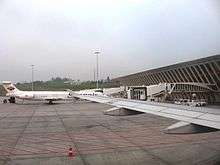
The three capitals have airports:
- Bilbao Airport (BIO) International
- Vitoria Airport (VIT)
- San Sebastián Airport (EAS)
Of the three, the most important hub and entry point to the Basque Country is Bilbao Airport, offering many international connections. Over 4,200,000 passengers passed through it in 2007.
Seaports
The two most important ports are the Port of Bilbao and the Port of Pasaia. There are other minor fishing ports like Bermeo and Ondarroa.
The Port of Bilbao is by far the most important in the Basque Country and the north of Spain, being the fourth most important in Spain with over 38 million tons of traffic.
All cruising routes arrive in Bilbao and there is a ferry service linking Bilbao with Portsmouth (United Kingdom).
Cuisine

Basque cuisine is an important part of Basque culture. According to the chef Ferran Adrià, San Sebastián "in terms of the average quality of the food, in terms of what you can get at any place you happen to walk into, maybe it is - probably it is, yes - the best in the world."[19] The most popular dishes are seafood, fish (for example Marmitako) and "Pintxos", bar finger food.
Basque food is one of the reasons for tourism to the Basque Country, especially the pintxos. A popular way to socialize is "ir de pintxos" or txikiteo, a Basque version of a pub crawl, albeit generally more civilized.
Sports
Basque rural sports, known as Herri Kirolak in Basque, are a number of sports competitions rooted in the traditional lifestyles of the Basque people, for example Basque pelota, the Basque version of the European game family that includes real tennis and squash. Basque players, playing for either the Spanish or the French teams, dominate international competitions
The Basque country is also home to former national football champions Athletic Bilbao from Bilbao. When Spain won the 2010 FIFA World Cup Xabi Alonso became the only Basque player to win both the World Cup and the club European Cup. Athletic is the most successful club in the community, and has a strict Cantera policy of employing only players born or trained in the Basque Country (greater region). Athletic's policy does not apply to head coaches, with famous names as Howard Kendall and Jupp Heynckes coaching the team at various points. In spite of this, the club shares with worldwide heavyweights Real Madrid and FC Barcelona the distinction of being the only clubs never to have been relegated from the top flight.[20]
Another major Basque Country club is Real Sociedad from San Sebastián, who contest the Basque derby with Athletic. Real Sociedad used to practice the same policy, until they signed Irish striker John Aldridge in the late 80s. Since then, Real Sociedad have had many foreign players. The region is also home to other La Liga clubs SD Eibar and Deportivo Alavés and Segunda División club CA Osasuna. The most renowned Basque footballer of all time is possibly Andoni Zubizarreta who holds the record for appearances in La Liga with 622 games and has won 6 league titles and 1 European Cup. Nowadays, the best known Basque football player is Xabi Alonso, winner of 2 UEFA European Championships and 1 World Cup, who played for Real Sociedad, Liverpool and Real Madrid and now plays for Bayern Munich. Other notable Basque players include Mikel Arteta, Javi Martinez, Iker Muniain, Fernando Llorente and Ander Herrera. Both Athletic and Real Sociedad have won the Spanish league, including domination as late as the early 1980s, with the last title won by a Basque club being Athletic's 1984 title.
Cycling as a sport is popular in the Basque Country. Miguel Indurain was born in Atarrabia (Navarre), and he won 5 French Tours. Fellow Basque cyclist Abraham Olano has won the Vuelta a España and the World Championship. The UCI World Tour Movistar Team hails from the Basque Country.[21] The Caisse d'Épargne cycling team traces its history back to the Banesto team that included Indurain. The region is home to the Tour of the Basque Country stage race and the Clasica de San Sebastian one day race. The Euskaltel–Euskadi team was also part of the World Tour until its disbandment in 2014. It was an unofficial Basque national team and was partly funded by the Basque Government. Its riders were either Basque, or at least have grown up in the Basque cycling culture, and former members of the team have been strong contenders in the Tour de France held annually in July and Vuelta a España held in September. Team leaders have included riders such as Iban Mayo, Haimar Zubeldia, Samuel Sánchez, David Etxebarria, Igor Antón, Mikel Landa and Mikel Nieve.
Notable people
Some notable Basque people from this administrative jurisdiction include Francisco de Vitoria, philosopher who set the theories of just war, international law and freedom of commerce; Juan Sebastián Elcano, completed first circumnavigation of the Earth; Ignatius of Loyola, founder of the Jesuits; Don Juan de Oñate, explorer of the great plains and Colorado river; Blas de Lezo, naval strategist, best remembered for his defensive tactics at the Battle of Cartagena de Indias; Jorge Oteiza sculptor; Paco Rabanne, fashion designer; Cristóbal Balenciaga, fashion designer; Xabi Alonso and Mikel Arteta, footballers; Edurne Pasaban, first woman to climb all of the fourteen eight-thousander peaks in the World; Elena Arzak, best female chef in the world (2012); Jon Kortajarena male model; Jose-Maria Cundin, artist; Fernando Savater philosopher; Miguel de Unamuno, essayist, novelist, poet, playwright, philosopher.
See also
References
- 1 2 "El 28,2% de la población que vive en el País Vasco ha nacido fuera | País Vasco". elmundo.es. Retrieved 2010-04-26.
- ↑ Michelena, Luis (1977). "El largo camino del euskera" (PDF). El Libro Blanco del Euskera. Euskaltzaindia. Retrieved 3 July 2013.
- ↑ IV. Inkesta Soziolinguistikoa Gobierno Vasco, Servicio Central de Publicaciones del Gobierno Vasco 2008, ISBN 978-84-457-2775-1
- ↑ Esparza Zabalegi, Jose Mari (1990). Euskal Herria Kartografian eta Testigantza Historikoetan. Euskal Editorea SL. pp. 52–54, 58. ISBN 978-84-936037-9-3.
- ↑ "Spain and its regions | Autonomy games". Economist.com. 2007-09-20. Retrieved 2010-04-26.
- ↑ "Archivo de Resultados Electorales". .euskadi.net. Retrieved 2010-04-26.
- ↑ "The Statute of Autonomy of the Basque Country" (PDF). Euskadi.net. Retrieved July 8, 2013.
- ↑ "Statute of Autonomy of the Basque Country". BOE.es (in Spanish). December 18, 1978. Retrieved July 8, 2013.
- ↑ "Azkuna: "Vitoria no es la capital de Euskadi"". El Correo. 2010-03-12. Retrieved 2010-09-09.
- ↑ Ayala, Alberto (2010-05-11). "Vitoria no será capital por ley, por ahora". El Correo. Retrieved 2010-09-09.
- ↑ Spanish regional accounts, INE.
- ↑ GDP per capita by province in the Basque Autonomous Community, 1980-2009(a), statistics published by Eustat (Basque Statistics Office). Retrieved 2010-12-08.
- ↑ "Euskadi es la comunidad que mejor ha resistido la crisis". EITB. 2015-04-13. Retrieved 2015-04-13.
- ↑ "Ocho de las diez localidades menos afectadas son vascas". El País. 2015-04-13. Archived from the original on 2015-04-13. Retrieved 2015-04-13.
- ↑ "Euskadi cerró 2013 con la tasa de paro más baja de España". El País. 23 January 2014.
- ↑ "Deuda Pública del País Vasco". Datos Macro. Retrieved 2014-04-23.
- ↑ "Deuda Pública de España". Datos Macro. Retrieved 2014-04-23.
- ↑ "EIB lends €1bn for Basque Y high speed network - Railway Gazette". Railway Gazette International. Retrieved 28 June 2012.
- ↑ Carlin, John (2005-03-13). "Is San Sebastián the best place to eat in Europe?". The Observer. Retrieved 2010-09-09.
- ↑ Mayr, Walter (11 April 2008). "Athletic Bilbao: How a proud Basque team is resisting globalization". Der Spiegel. Retrieved 19 May 2015.
- ↑ "2009 Riders and teams Database - Cyclingnews.com". Retrieved 14 August 2009.
- Pierson, Peter (1999). The History of Spain. Westport, Connecticut: Greenwood Publishing Group. ISBN 0-313-30272-3.
- Trask, Robert Lawrence (1997). The History of Basque. London: Routledge. ISBN 0-415-13116-2
External links
| Wikimedia Commons has media related to Basque Autonomous Community. |
| Wikisource has the text of the 1911 Encyclopædia Britannica article Basque Provinces. |
 Basque Country travel guide from Wikivoyage
Basque Country travel guide from Wikivoyage- Basque Government
- José Aranda Aznar, “La mezcla del pueblo vasco”, en Empiria: Revista de metodología de ciencias sociales, ISSN 1139-5737, Nº 1, 1998, págs. 121-180.
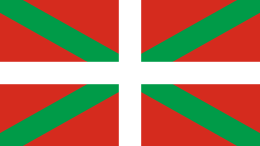

.jpg)